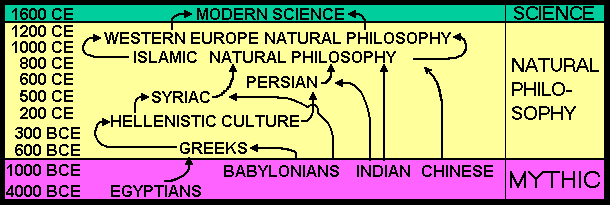|
ISAAC NEWTON, Sir (1642-1727)
The son of a poor illiterate farmer, Newton became the first scientific
superstar. He entered Cambridge University in 1661 and was granted the
degree of Bachelor of Arts in 1665. He left Cambridge for the country from
1665-1666 because the black plague had struck. In 1669 he was appointed
Professor of Mathematics at Trinity College in Cambridge, eventually knighted
for his achievements, his scientific reputation was unmatched until Einstein
in this century. In mathematics, he discovered the binomial theorem and
formulated the calculus. In 1666, he was able to establish that light is
made up of colors that could be separated by a prism. In his Discourse
on Optiks he described the laws of refraction and reflection. At
about the same time, he explained the causes of motion (dynamics) in his
celebrated three mathematical laws that encompass the motion of all objects,
terrestrial or celestial. Central to this explanation is the notion of
force.
-
Law 1. Inertia. Objects at rest remain at rest, and objects in unaccelerated
motion remain in unaccelerated motion.
-
Law 2. F= MA. Forces cause masses to accelerate. Acceleration is
proportional to the force and is in the direction in which the force is
applied.
-
Law 3. Forces come in pairs. Forces arise from interactions and
in any interaction, the force on one object is equal in amount and opposite
in direction to the force on the other object.
He also realized that the same force that pulls apples to the ground was
also responsible for keeping the planets in their orbits and thus he formulated
the universal law of gravity among his many other accomplishments. By 1669
he had also perfected the reflecting telescope.
Beyond Newton
From Newton's time, one of the main currents of astronomical accomplishments
focuses once again on expansion of our knowledge of the Solar System, a
rich tradition that continues into our own century. In 1781, Herschel
discovers Uranus. In 1846 Galle discovers
Neptune. In 1930 Clyde Tombaugh discovers
Pluto, and in 1978, Christy discovers Pluto's
moon Charon. Nor should the legacy of discoveries from the space age be
left unmentioned, as our travels to the moon and continued exploration
of the Solar System by unmanned probes have enriched our knowledge and
understanding immeasurably.
In the 20th Century, astronomy expands beyond the Solar System and the
Milky Way and becomes truly universal. With the discovery of variable cepheids
(a type of star that can be used to determine distances) in spiral nebulae,
Hubble is able to show that these spiral nebulae
lie way outside the Milky Way, and thereby radically expands our concept
of the size and richness of the universe. Mathematically,
Einstein introduces a relativistic universe.
Summary chart of influences that lead to modern science

|





